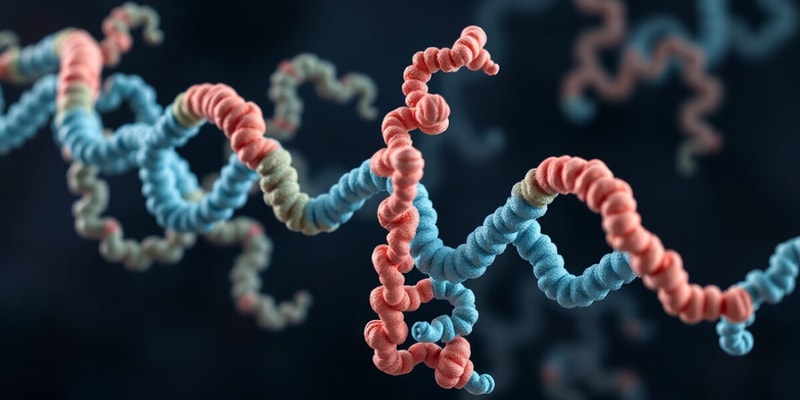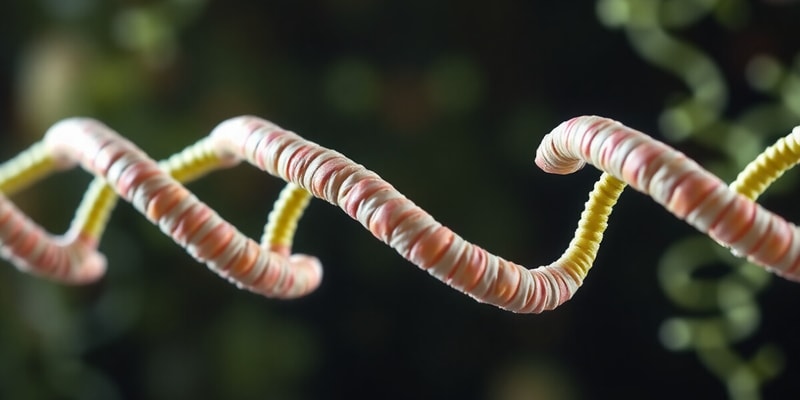Podcast Beta
Questions and Answers
What is the significance of HCl in protein metabolism during digestion?
HCl denatures proteins, making them more accessible to proteolytic enzymes, and activates pepsinogen into pepsin for protein breakdown.
Identify three key biological roles of proteins and provide an example for each.
Proteins serve in catalysis (enzymes), transport (hemoglobin), and mechanical support (collagen).
What are proteolytic enzymes, and how do they contribute to protein metabolism?
Proteolytic enzymes, such as pepsin and trypsin, break down proteins into smaller peptides and amino acids, facilitating nutrient absorption.
Briefly describe the process of metabolism with respect to anabolism and catabolism.
Signup and view all the answers
Mention a clinical disorder associated with protein metabolism and its implication.
Signup and view all the answers
What are the structural differences between globular and fibrous proteins?
Signup and view all the answers
Explain the role of enzymes as globular proteins in metabolism.
Signup and view all the answers
Identify the primary function of collagen in the body.
Signup and view all the answers
How does protein digestion begin in the stomach?
Signup and view all the answers
What are zymogens and their purpose in protein digestion?
Signup and view all the answers
Describe the three phases of protein digestion.
Signup and view all the answers
What role does nitrogen play in amino acid metabolism?
Signup and view all the answers
What is the significance of hydrophilic amino acids being exposed on globular proteins?
Signup and view all the answers
What role does HCl play in gastric digestion?
Signup and view all the answers
How is pepsin activated and what is its function?
Signup and view all the answers
List the key endopeptidases found in pancreatic juice and their importance.
Signup and view all the answers
What is the function of bicarbonate secreted by the pancreas during digestion?
Signup and view all the answers
Differentiate between endopeptidases and exopeptidases.
Signup and view all the answers
What specific amino acids do trypsin and chymotrypsin preferentially cleave?
Signup and view all the answers
How are di- and tri-peptides processed after absorption in enterocytes?
Signup and view all the answers
What stimulates the secretion of pancreatic juice?
Signup and view all the answers
How are dipeptides and tripeptides processed after entering mucosal cells?
Signup and view all the answers
What is the primary route of absorption for amino acids in the small intestine?
Signup and view all the answers
What consequence can arise from the paracellular absorption of larger protein molecules?
Signup and view all the answers
What clinical condition is caused by the immune response to gluten, and what is its effect on the small intestine?
Signup and view all the answers
What initiates the process of acute pancreatitis related to protein digestion?
Signup and view all the answers
What results from a deficiency in pancreatic secretion regarding protein digestion?
Signup and view all the answers
How are free amino acids released from enterocytes into the portal system?
Signup and view all the answers
Explain the significance of energy in the absorption process of amino acids within the small intestine.
Signup and view all the answers
Study Notes
Protein Structure and Function
- Proteins are nitrogenous organic compounds composed of amino acid chains linked by peptide bonds.
- There are 20 common amino acids, each with a unique R group.
- Proteins have diverse biological roles, including catalysis (enzymes), transport (hemoglobin), storage (myoglobin), motion (actin and myosin), support (collagen), protection (antibodies), and regulation (hormones).
- Globular proteins are coiled, with hydrophobic amino acids inside and hydrophilic ones outside, making them soluble and involved in metabolic reactions. Examples include enzymes and hemoglobin.
- Fibrous proteins have long parallel chains linked by disulfide bridges, providing structural strength. Examples include keratin and collagen.
Protein Metabolism
- Metabolism comprises anabolism (synthesis) and catabolism (breakdown).
- Nitrogen enters the body through dietary amino acids and leaves as urea, ammonia, and other metabolites.
- Protein digestion involves three phases: gastric, pancreatic, and intestinal.
Gastric Digestion
- Cooking denatures proteins, making them easier to digest.
- Gastrin stimulates HCl secretion, lowering stomach pH to 1-2.
- HCl acts as an antiseptic and denatures proteins.
- Pepsin, an endopeptidase, hydrolyzes peptide bonds involving specific amino acids (Phe, Tyr, Trp, Met).
Pancreatic Digestion
- Pancreatic juice contains endopeptidases (trypsin, chymotrypsin, elastase) and carboxypeptidase.
- These are secreted as inactive zymogens to prevent autodigestion.
- They are serine proteases with serine residues in their active sites.
- Optimal pH is 8, maintained by bicarbonate secreted in response to secretin.
- Cholecystokinin stimulates pancreatic juice secretion.
- Endopeptidases cleave internal peptide bonds, while exopeptidases (carboxypeptidases, aminopeptidases) cleave terminal bonds.
- Trypsin targets arginine and lysine residues; chymotrypsin targets aromatic amino acids; elastase targets hydrophobic amino acids.
Intestinal Digestion and Absorption
- Final digestion yields free amino acids, dipeptides, and tripeptides.
- Di- and tripeptides are absorbed and hydrolyzed within enterocytes.
- Amino acids are transported into portal blood via sodium-dependent and -independent transporters.
- Most globular proteins are completely hydrolyzed, but some fibrous proteins (e.g., keratin) are only partially digested.
Clinical Significance
- Food allergies can result from the absorption of partially digested proteins.
- Celiac disease is an immune response to gluten, damaging the small intestine.
- Acute pancreatitis arises from premature trypsinogen activation within the pancreas.
- Pancreatic insufficiency (e.g., due to chronic pancreatitis, cystic fibrosis, or pancreatectomy) impairs fat and protein digestion and absorption.
Studying That Suits You
Use AI to generate personalized quizzes and flashcards to suit your learning preferences.
Related Documents
Description
Test your knowledge on the structure and functions of proteins, including their biological roles and metabolism. This quiz covers the different types of proteins, such as globular and fibrous proteins, as well as the process of protein metabolism.




